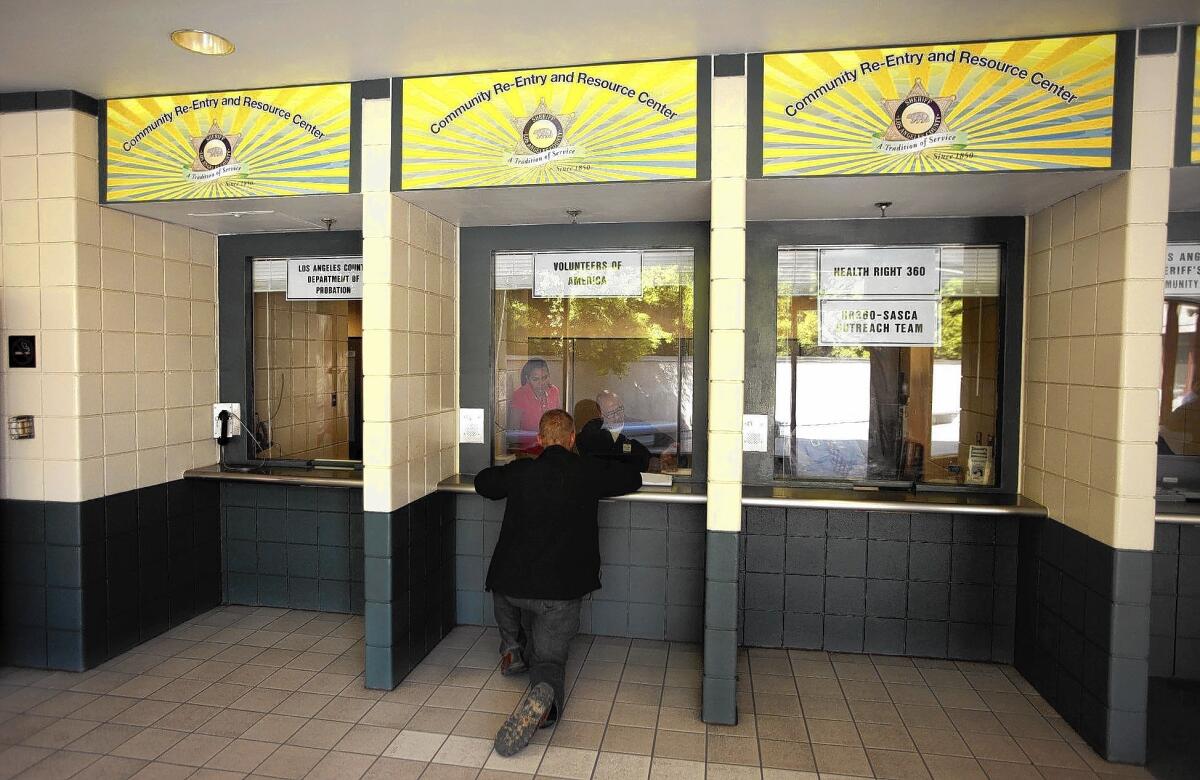L.A. sheriff’s center aims to smooth inmates’ reentry into society

- Share via
The 40-year-old man in the black jacket and jeans was getting out of jail with no money and no place to live.
As he left the county jail complex in downtown Los Angeles, he stopped at the new Community Re-entry Resource Center, where he received a bus token and a referral to a homeless shelter. The man, who would give only his first name, David, got a phone number for the police so he could see whether his car had been impounded while he was imprisoned.
The center, which opened at the end of May and is run by the Sheriff’s Department, helps people leaving the jails adjust to life on the outside, in hope they won’t come back again.
Newly released inmates get assistance with food stamps, mental health services and health insurance. A probation officer is on hand, along with officials from various county departments. The nonprofits HealthRight 360 and Volunteers of America offer referrals to job centers and substance abuse programs.
“They go back to their old neighborhood and fall into the same trap, with the same friends, and they end up right back in jail,” said Sgt. Joaquin Soto. “We’re trying to avoid that.”
David said he was behind bars for six days after missing a court appearance related to a drug offense. But that was enough to set him back. He had been living out of his car and has no family in the area. He needed something to tide him over until he started a new job in a few days.
“They’re helping me out at just the right time,” he said.
Inside the jails, the sheriff’s Community Transition Unit provides similar services. On the way out, the drop-in reentry center offers a final chance for newly released inmates to get the services they need, said sheriff’s officials and reentry experts.
Each month, more than 5,000 men from Men’s Central Jail, Twin Towers, Pitchess Detention Center and several other sheriff’s facilities pass by the reentry center’s plexiglass windows after picking up their belongings and money at the downtown complex. Some walk out without stopping. The center, in the Twin Towers lobby, will eventually have a welcoming officer to flag people down and explain its offerings.
Those who have been out for a while and need help are welcome to return to the center, sheriff’s officials said.
“When the doors open, they’re faced with people who are honestly caring, who give them tokens, soap and shampoo. It’s a sense of caring, connection and community,” said Demetrius Andreas, vice president of community reentry services for HealthRight 360. “It reduces the possibility that they’re going to get out and have nowhere to go.”
Renovating the jail lobby cost about $800,000, which came from the county’s inmate welfare fund, Lt. Xavier Aguilar said. The center, which is open from 5 a.m. to 5 p.m. Monday through Friday, is run by existing staff.
At an opening ceremony, Interim Sheriff John Scott called the center an “innovative and forward-thinking” way to return former inmates to the community.
Brian Biery, director of community organizing at the Flintridge Center in Pasadena, said the reentry center has “great potential” but that there should be such facilities throughout the county.
“My concern is once people leave, what would be the reason for them to come back?” Biery said. “Do they just get sent there when they’re being released? That’s helpful, but is there the expectation to come back?”
On another recent morning in the jail lobby, Larry Lucero was turning himself in after missing a date with his probation officer. He recently finished a two-year sentence on a drug charge, he said, and was about to serve more time because of the missed appointment.
When he left the jail in March, he received a bus token, which wasn’t enough to get him home to the Antelope Valley. He panhandled until he got enough cash, he said.
Jail officials said they help released inmates get to all corners of the county and are not sure how Lucero fell through the cracks. Lucero, 38, said he doesn’t expect much help anyway.
“It’s not their problem. You’re here for a reason,” he said. “When you get out, you’re on your own.”
But while waiting to check into jail again, Lucero took advantage of the reentry center to move his probation case to San Diego, where his wife lives.
“They are trying, so we have a fighting chance when we get out,” he said.
More to Read
Sign up for Essential California
The most important California stories and recommendations in your inbox every morning.
You may occasionally receive promotional content from the Los Angeles Times.











